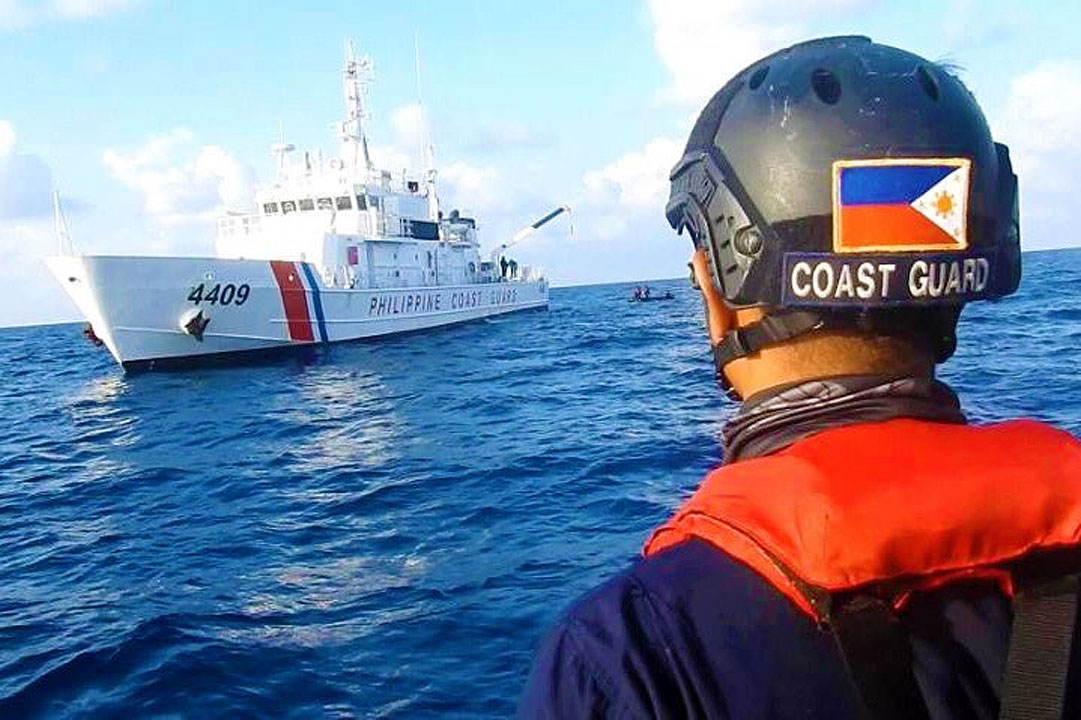Chinese Coast Guard, Navy keep ‘swarming’ tactics in disputed sea

By Kenneth Christiane L. Basilio, Reporter
CHINESE vessels lingered near contested areas in the South China Sea last month, in line with China’s “swarming” and “gray-zone” strategies amid heightened regional tensions, the Philippine military said on Tuesday.
China sent the biggest number of ships to Scarborough Shoal in May — 15 coast guard vessels and 11 navy ships, military spokeswoman Colonel Francel Margareth Padilla-Taborlupa told a news briefing.
“As part of continued maritime surveillance, Chinese government-affiliated vessels remained persistently present in key areas in the West Philippine Sea,” she said, referring to areas of the South China Sea within the Philippines’ exclusive economic zone (ecozone).
“Chinese vessels were sighted intermittently throughout various features of the Kalayaan Island Group (Spratly Islands) and other Philippine maritime zones, consistent with patterns of maritime swarming and gray-zone activity,” she added.
The Chinese Embassy in Manila did not immediately reply to a Viber message seeking comment.
The Philippines has been irked by the presence of Chinese ships within its ecozone. China claims nearly all of the South China Sea via a U-shaped, 1940s nine-dash line map that overlaps with the exclusive waters of the Philippines and neighbors like Vietnam and Malaysia.
A United Nations-backed tribunal in 2016 voided China’s sweeping claims for being illegal, a ruling that Beijing does not recognize.
Meanwhile, six Chinese coast guard vessels were monitored loitering near Second Thomas Shoal alongside a People’s Liberation Army-Navy ship, Ms. Taborlupa said. Four Chinese Coast Guard and Chinese Navy vessels were also spotted around Thitu Island. Both are occupied by the Philippines.
She said some vessels did not respond when they were challenged by Philippine ships via radio. “Despite the number of nonresponsive vessels, it did not result in… confrontations with friendly forces.”
The presence of Chinese vessels within the country’s ecozone are “disturbing” and “concerning,” Philippine Navy spokesman Rear Admiral Roy Vincent T. Trinidad told the same briefing.
“Their actions, which are coercive and aggressive, are concerning,” he said. “They are disturbing. Their illegal presence, their coercive and aggressive actions and their deceptive messaging have been the cause of all the turmoil in the West Philippine Sea.”
Meanwhile, an advanced mobile anti-ship missile system brought by the US earlier this year for Balikatan (shoulder-to-shoulder) exercises is still in the Philippines and is being used for training, Philippine Navy spokesman Captain John Percie Alcos told reporters at the briefing.
“The NMESIS (Navy-Marine Expeditionary Ship Interdiction System) will remain here in our country for as long as training opportunities are still there for us,” he said.
Familiarizing Filipino troops with the advanced US anti-ship missile battery would train them against sea invasions,” Mr. Alcos said. “This will be extremely helpful if amphibious raids or amphibious landings are planned against our country.”
The Philippine Navy plans on having its own NMESIS unit and has submitted its request to the Defense department, he said.
“The acquisition of long-range missile systems or rocket systems is one of the capabilities that we intend to have,” he said. “We have already submitted the list of capabilities that are critical and crucial for the Philippine Navy to the higher headquarters and the Department of National Defense.”
DEEPER COOPERATION
Meanwhile, Manila and Washington have agreed to bolster cooperation to address Beijing’s aggression in the South China Sea, after a meeting between Philippine Foreign Affairs Secretary Enrique A. Manalo and US State Secretary Marco Rubio.
“Secretary Rubio and Secretary Manalo committed to deepening cooperation on addressing China’s destabilizing actions in the South China Sea and to increasing economic cooperation to mutually benefit American and Philippine citizens,” State department Spokesperson Tammy Bruce said in a statement.
Mr. Manalo and Mr. Rubio met during a working visit by the Philippine envoy to the US on June 9 to 11.
Separately, the Department of Foreign Affairs (DFA) said both secretaries supported continued cooperation in defense and security, including sustaining Manila’s military modernization efforts.
The Philippines seeks to boost its defense capabilities through more foreign partnerships amid worsening ties with China. It has also increased its defense budget, with about P35 billion allotted to modernize its military in the next decade.
The South China Sea has become a boiling point for regional tension as China continues to assert dominance over areas claimed by the Philippines, Vietnam, Malaysia, Brunei and Taiwan.
The Philippines and China have repeatedly clashed in the disputed waterway, with both sides accusing each other of raising tensions.
“The secretaries looked forward to the positive conclusion of high-level talks between Philippine and US economic managers on the US’ reciprocal tariffs,” the DFA said.
Last month, Philippine officials met with the US Trade Representative to negotiate the 17% reciprocal tariff imposed by the US on the Philippines.
“They also underscored the importance of stronger economic relations in building a more enduring Philippines-US alliance and promoting overall security,” the agency said.
The two envoys also committed to explore opportunities for cooperation with regional allies and partners, including trilaterally with Japan through the Luzon Economic Corridor, it added. — with Adrian H. Halili



